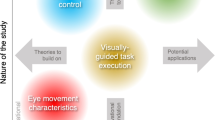Abstract
The purpose of our contribution was to make an inventory of the trade-offs between looking at the moving image and processing the subtitle. Does reading occur? Is there successive scanning from the pictures to the subtitles and from the subtitles back to the pictures? Could both forms of information be processed simultaneously with no loss of understanding of the flow of information in the moving image? What information is captured in peripheral and parafoveal vision, and how is it used in the purposive sequence of eye movements?
Preview
Unable to display preview. Download preview PDF.
Similar content being viewed by others
References
Baddeley, A.D., Hitch, G. (1974). Working memory. The psychology of learning and motivation, Vol. VIII. Bower, G.H. (Ed.). Academic Press, New York.
Broadbent, D.E. (1958). Perception and communication. Pergamon Press, Oxford.
Broadbent, D.E. (1971). Decision and stress. Academic Press, London.
Davis, R., Moray, N., Treisman, A. (1961). Imitative responses and the rate of gain of information. Quarterly Journal of Experimental Psychology, 13, 79–91.
Gopher, D., Brickner, M., Navon, D. (1982). Different difficulty manipulations interact differently with task emphasis: Evidence for multiple resources. Journal of Experimental Psychology: Human Perception and Performance, 8, 146–157.
Haber R.N., Hershenson, N. (1973). The psychology of visual perception. Holt, New York.
Just, M.A., Carpenter, P.A. (1980). A theory of reading: From eye fixations to comprehension. Psychological Review, 87, 329–354.
Leisman, G. (1973). Oculo-motor system control of position anticipation and expectation: Implications for the reading process. Eye movements and the higher psychological functions. Senders, J.W., Fisher, D.F., Monty, R.A. (Eds.). Hillsdale, New Jersey.
Massaro, D.W., Taylor, G.A., Veneszky R.L., Jastrembski J.E., Lucas, P.A. (1980). Letter and word perception. North-Holland, Amsterdam.
Moray, N. (1960). Broadbent's filter theory: Postulate H and the problem of switching time. Quarterly Journal of Experimental Psychology, 12, 214–221.
Muylaert, W., Nootens, J., Poesmans, D., Pugh, A.K. (1983). Design and utilisation of subtitles on foreign language television programmes. Theorie, Methoden und Modelle der Kontaktlinguistik. Nelde, P.H. (Ed.). Dummler, Bonn.
Muylle, P. (1984). Oogbewegingsregistratie bij het bekijken van anderstalige ondertitelde televisieprogramma's. Niet-gepubliceerde licentiaatsverhandeling. Leuven.
Navon, D. Gopher, D. (1979). On the economy of the human information processing system. Psychological Review, 86, 214–253.
Navon D., Gopher, D. (1980). Task difficulty, resources, and dual task performance. Attention and performance, Vol.VIII. Nickerson R.S. (Ed.). Erlbaum, Hillsdale.
Neisser, U. (1967). Cognitive psychology. Prentice-Hall, Englewood Cliffs.
Rayner, K. (1978). Eye movements in reading and information processing. Psychological Bulletin, 85, 616–660.
Rayner, K. (Ed.) (1983). Eye movements in reading: Perceptual and language processes. Academic Press, New York.
Schneider, W., Shiffrin, R.M. (1977). Controlled and automatic human information processing: I. Detection, search, and attention. Psychological Review, 84, 1–66.
Shiffrin, R.M., Schneider, W. (1977). Controlled and automatic human information processing: II. Perceptual learning, automatic attending, and a general theory. Psychological Review, 84, 127–190.
Treisman, A. (1968). Strategies and models of selective attention. Psychological Review, 76, 282–299.
Voge, H. (1977). The translation of films: Subtitling versus dubbing. Babel, 23, 120–125.
Author information
Authors and Affiliations
Editor information
Rights and permissions
Copyright information
© 1984 Springer-Verlag Berlin Heidelberg
About this paper
Cite this paper
d'Ydewalle, G. (1984). Processing TV information and eye movements research. In: van der Veer, G.C., Tauber, M.J., Green, T.R.G., Gorny, P. (eds) Readings on Cognitive Ergonomics — Mind and Computers. Lecture Notes in Computer Science, vol 178. Springer, Berlin, Heidelberg. https://doi.org/10.1007/3-540-13394-1_17
Download citation
DOI: https://doi.org/10.1007/3-540-13394-1_17
Published:
Publisher Name: Springer, Berlin, Heidelberg
Print ISBN: 978-3-540-13394-0
Online ISBN: 978-3-540-38944-6
eBook Packages: Springer Book Archive



